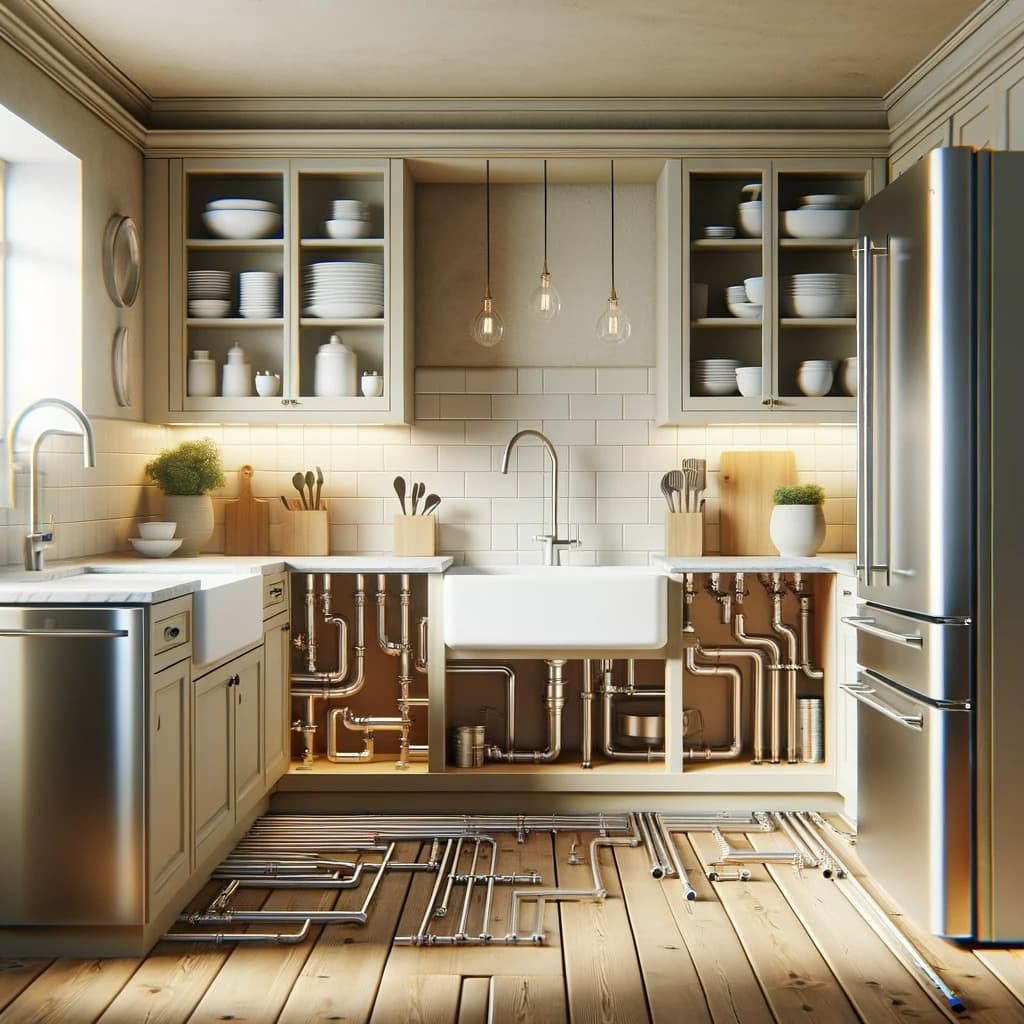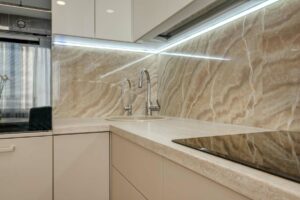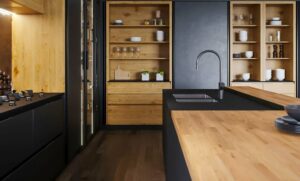When beginning any kitchen remodel, one of the most important early steps is thoroughly assessing the current state of your kitchen’s plumbing system. Evaluating your existing plumbing layout, materials, functionality and potential issues allows you to determine what updates or changes may be necessary or desired with your kitchen remodel plumbing plans.
Assessing Your Current Kitchen Plumbing

During this initial kitchen plumbing inspection, key areas to review include:
Water supply lines
Check under sinks and along walls for signs of leaks, corrosion, or other damage on supply lines. Assess accessibility of water shut off valves as well. Consider material (copper, galvanized steel, PEX) and estimate age.
Drain lines
Look for any evidence of leaks or deterioration on visible drain lines. Check for signs of clogging issues. Assess accessibility of cleanouts.
Fixtures
Turn on both hot and cold water for every faucet and fixture. Check for adequate water pressure, signs of leaks, odd noises, or insufficient drainage.
Ventilation
Run multiple fixtures simultaneously and check for any gurgling that may indicate undersized plumbing vents.
Appliance hookups
Ensure water and drainage connections to dishwashers, sinks, refrigerators with ice makers, etc. are free of leaks and in good condition.
Having a professional plumber conduct this inspection and consult with you on your intended kitchen remodel plans is highly recommended. Issues with old, corroded plumbing often don’t become apparent until you start adjustments for the remodel. Getting an expert assessment early allows you to budget appropriately and avoid unforeseen delays.
Determining Your New Kitchen Plumbing Needs
Once you have a firm understanding of your current kitchen plumbing system’s overall condition, the next vital step is determining what your new plumbing requirements will be after the remodel. Key factors to consider:
Desired layout changes
- Will you be moving or expanding plumbing fixtures like sinks or dishwashers?
- Do you plan to add an island or bar with a sink?
- Will the sink, refrigerator, dishwasher be in different locations requiring water supply and drain line adjustments?
New appliances
- Will your remodel involve installing new larger appliances like a commercial range needing a higher GPM flow rate?
- Do you intend to add undercounter ice makers or instant boiling water taps requiring dedicated water lines?
Current and future usage
- Do you currently experience any water pressure or drainage issues?
- Will your new kitchen layout involve increased usage of multiple fixtures simultaneously?
- Are there ways to optimize and improve your existing kitchen plumbing functionality?
Carefully thinking through details such as where you want sinks, faucets, soap dispensers and taking into account new appliances and intended usage will help you thoroughly plan for your new ideal kitchen plumbing layout and avoid frustrating issues down the road.
The key elements of any kitchen plumbing system that must be accounted for are:
- Hot and cold water supply lines
- Main kitchen sink drainage
- Dishwasher drainage
- Garbage disposal
- Venting
- Convenient placement of water shutoffs
- Adequate space allowed for pipes and supply lines
Working with Plumbing Professionals on Kitchen Remodels

While simple plumbing projects can potentially be DIY, attempting plumbing modifications during kitchen remodels as a non-professional is typically not advisable. The expertise of licensed plumbers and coordination with general contractors is crucial for kitchen remodel plumbing work.
Key reasons to have plumbing professionals handle your kitchen remodel plumbing needs:
Expertise Identifying Potential Issues
Experienced plumbers can spot signs of problems or deficient existing infrastructure the average homeowner could miss. This prevents headaches down the road.
Knowledge of Building Codes and Permits
Plumbers stay updated on the latest local building codes and ensure necessary permits are obtained before work begins. Failure to do so could jeopardize passing inspections.
Precision Skillset
The complex nature of adjusting supply lines, venting, drainage for a full kitchen remodel requires skills and tools the average homeowner lacks. Leaks from improper installations can be disastrous.
Efficiency and Warranties
Well-reviewed professionals have project management experience that lends to greater efficiency. Reputable plumbers also often warranty installations from defects. Attempting extensive plumbing modifications without professional help risks wasted time, money and subpar outcome.
While a general contractor typically oversees full kitchen remodel project coordination, make sure communication with plumbers is early and ongoing in the process regarding timelines and kitchen layout plans. Establishing a collaborative relationship leads to the best final remodel plumbing result.
Updating Supply Lines in Kitchen Remodeling Projects
When remodeling your kitchen, updating old or deteriorating water supply lines is generally recommended. Benefits include:
- Accommodating any layout changes like new sink or appliance locations
- Ensuring adequate water flow and pressure to new fixtures
- Improving overall functionality and longevity
Common water supply line upgrades in kitchen remodels involve:
- Replacing galvanized steel pipes prone to rust and sediment buildup with copper, PEX or CPVC
- Adjusting pipe routes to accommodate sink relocations or additions
- Increasing pipe diameter if flow rate is insufficient for new fixtures
- Installing convenient shutoff valves for sinks and appliances
Proper planning of new water supply line routing is crucial before installing and enclosing new walls. Key steps when updating lines include:
- Measure carefully between new sink/appliance locations and water heater to cut piping to precise required lengths
- Connect to main household water lines using code-approved fittings
- Anchor pipes properly to studs/joists to prevent movement and strain on joints
- Pressure test new piping before enclosing walls to check for leaks
A professional plumber has the expertise to ensure updated water lines meet local building codes and provide optimal flow. Attempting supply line modifications without experience risks dangerous leaks or failing inspections.
Rerouting Sewer and Drain Lines
In addition to updating supply lines, kitchen remodels often involve adjustments to drain lines and waste venting. Reasons you may need to reroute drains when renovating kitchens include:
- Relocating the main kitchen sink
- Adding a new island/bar sink
- Moving the dishwasher to a different wall
- Upgrading old steel drain pipes to PVC
When planning drain line position changes, key factors plumbers consider are:
Maintaining proper slope
Drain lines must slope 1⁄4 inch per linear foot towards the main sewer connection to facilitate gravity drainage. Installing new horizontal runs requires precision planning.
Avoiding sharp bends
While some gentle bends are inevitable, sharp 90 degree angles can easily clog. Sweeping bends or cleanouts may be necessary.
Venting requirements
Any relocated sinks/appliances tied to drain lines require proper venting to facilitate water outflow and prevent gurgling.
Installing cleanouts
Straight access points allowing cleaning of drain blockages are required at regular intervals and connection points.
Like supply lines, hoping to DIY major rerouting of kitchen drainage is extremely difficult and perilous for non-professionals. Having an experienced plumber handle this using code-approved materials prevents headaches.
Ventilation Requirements for New Kitchen Plumbing
Proper ventilation is crucial for facilitating efficient drainage in any remodeled kitchen plumbing system. Two main strategies plumbers employ to meet ventilation code include:
1. Air Admittance Valves (AAVs)
AAVs are one-way mechanical vents installed at fixture connection points allowing air to enter drain lines, thus enabling water to flow freely while preventing sewer gases from escaping.
Key benefits:
- Allow flexibility in layouts where traditional pipe vents are difficult
- Easy for plumbers to install during kitchen remodels
- More aesthetically pleasing than pipe protrusions
2. Traditional Pipe Vents
These vents made of PVC or other piping physically extend sinks drain lines above the flood rim, while hidden from living spaces. They utilize natural air pressure differentials for ventilation.
Benefits:
- Tried and true standard method
- Often easiest route for direct sink drain line runs
Per code, kitchen island sinks specifically require dedicated mechanical AAVs or adjacent plumbing walls for pipe vents.
In any drain line rerouting, plumbers know exactly where vents are needed to meet regulations. Attempting kitchen plumbing alterations without proper ventilation knowledge risks failing inspection.
Installing New Sinks and Fixtures
A major aspect of any kitchen remodel is choosing and correctly installing upgraded sinks and plumbing fixtures like faucets, soap dispensers, filtered water taps, etc. Key considerations are:
Sink Material
Popular options like stainless steel, enamel ceramic, composite granite, and fireclay have pros and cons regarding durability, heat resistance, staining, price point and aesthetics. Assess your budget, usage needs and decor goals.
Mounting Style
Undermount, Self-rimming/drop-in, Tile-in, and Farmhouse/Apron-front styles suit different countertop materials and visual tastes. Measure precisely to cut holes accurately.
Faucet Style
Choices like widespread, centerset, single-handle, hands-free, articulating, bar faucets, etc. vary regarding quality, features, installation requirements and visual appeal.
Island Specifics
Island sinks bring unique support needs. Special reinforced custom cabinetry ensures weight capacity. Integrated solid surface platforms simplify install.
Professional Installation
While swapping out basic faucets may be DIY-friendly, correctly mounting new heavy sinks in countertops and connecting supply/drain lines is best left to experts. Risks of leaks or failure down the road otherwise outweigh supposed cost savings for non professionals.






